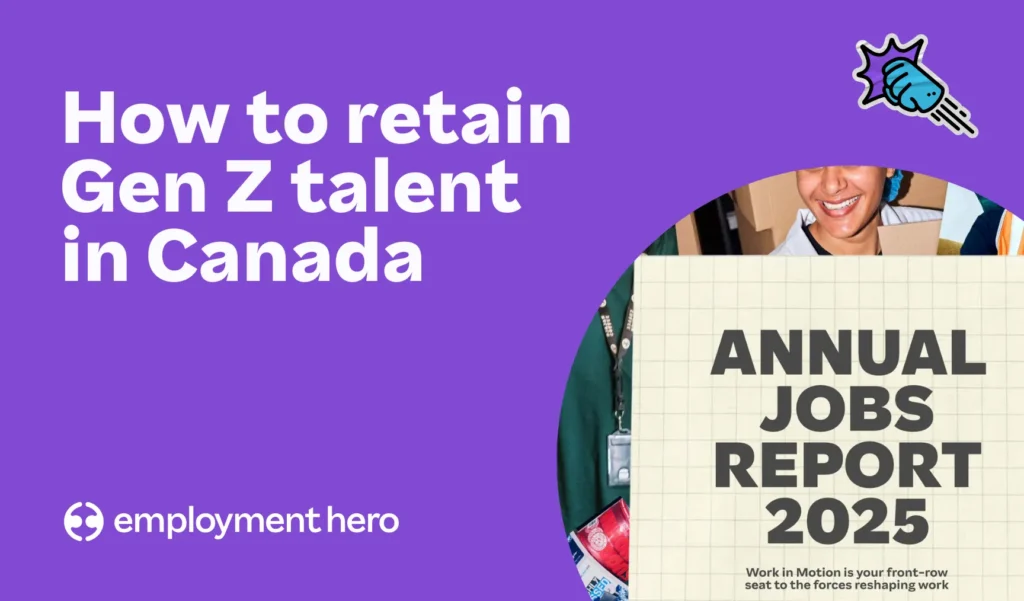5 ways to retain Gen Z talent in Canada

Contents
Gen Z talent is reshaping how work gets done across Canada. They came of age through economic shocks, entered the market amid a cost-of-living crunch and are finding their feet as AI changes job design. They measure employers by clarity, balance and momentum. If a role stalls, they move.
For SMB leaders, this is not a nice-to-solve problem. It is your hiring budget, your customer experience and your succession plan. Hold onto Gen Z, and they’ll pay it forward with energy, fresh ideas and loyalty that strengthens your culture over time.
Employment Hero’s 2025 Annual Jobs Report paints a clear local picture. One third of Canadians in full-time roles now hold more than one job, with younger workers leading that pattern. More than half of 18–24-year-olds say they would relocate for the right opportunity. Across the country, 53% of workers prefer roles with less pressure, highest in Quebec and lowest in Atlantic Canada. Twenty-two percent say their ideal job is self-employment. These aren’t nice-to-know stats. They are design signals for any Canadian SMB serious about retaining Gen Z.
Here are five strategies that work.
1. Know who Gen Z workers really are in Canada
Retention starts with recognizing the conditions Gen Z work within. This isn’t just about perks; it’s about building a framework that respects their needs. To do this, you must confront three key realities: poly-employment, regional differences and their desire for mobility.
- Poly-employment is a fact: One in three Canadians with a full-time job also hold another role. For younger workers, this is often less about passion projects and more about paying the bills. Policies that penalize disclosure create distrust. A clear framework that defines conflicts and approves side work quickly signals respect and builds loyalty.
- Regional differences also shape expectations. In Quebec, 60% of workers prefer lower-pressure roles. In Atlantic Canada, 47% feel the same. A single national retention policy will not land evenly. Quebec may need capped overtime, additional mental health days and proactive workload monitoring. In Atlantic Canada, where more workers are open to higher pressure roles, rotational projects or early leadership pathways may be a better fit.
- Mobility is another defining trait. Over half of Canadians aged 18–24 say they would relocate for the right role, with Ontario workers the most open to moving. Not every SMB can afford relocation packages, but internal mobility can serve the same purpose. Short-term cross-team projects or temporary placements give Gen Z talent new challenges without leaving the company.
The signals to watch here are straightforward: the rate of side work disclosure, attrition within the first year, participation in cross-team projects and engagement scores by province.
2. Show Gen Z that their effort leads somewhere
Younger employees will put in effort when they can see where it takes them. Sixty-two percent of Canadians under 25 already work longer hours to advance their careers. Without visible recognition, that effort goes elsewhere.
Replace career ladders with a map: Forget traditional career ladders that can feel like a slow, secret climb. Instead, create a one-page role map. This isn’t a long-form job description; it’s a simple, visual guide that transparently shows the skills, responsibilities, and pay bands for every level.
For example, your map for a “Marketing Coordinator” might show that mastering campaign analytics and taking on a client-facing role are the two key milestones that unlock the “Marketing Specialist” title and a clear salary bump. When a promotion is tied to demonstrable skills — not just waiting for a manager’s whim — it feels fair.
Make progression regular and predictable: Quarterly progression windows give employees multiple chances to move forward in small steps rather than one big annual leap. Mentorship and sponsorship programs add another layer: a mentor builds skills while a sponsor advocates when decisions are made.
Turn onboarding into a launchpad: Onboarding is another chance to demonstrate momentum. The first 90 days should be structured around outcomes, not just introductions. A quick win in the first two weeks, a measurable improvement by week six and a customer-facing impact by day 90 prove to employees that their work matters from the start. Closing the probation period with a written growth plan locks in that sense of forward motion.
Retention lives in these rhythms. Track the percentage of new hires completing growth plans within 90 days, the share of staff progressing each quarter and the reduction in early attrition once visible steps forward are part of your system.
Keep your Gen Z talent growing with you.
3. Balance ambition with stability
Security is the anchor of ambition. The Jobs Report shows more than half of Canadian workers prefer lower-pressure roles. For Gen Z, this doesn’t mean ambition disappears. It means they won’t sacrifice wellbeing for advancement.
Security starts with pay. Publish clear salary bands for every level and the skills that unlock each step. Managers should be trained to explain these frameworks the same way across teams. Predictable scheduling also signals stability. Rosters published at least two weeks ahead, with self-serve swaps approved quickly, help employees balance side hustles or education with their main role.
Workload capacity is another test. Quarterly audits prevent burnout by identifying where demand regularly outpaces resources. When a team is stretched past 100% capacity for weeks on end, leaders need to cut scope or increase headcount rather than expecting extra effort.
Finally, wellbeing support needs to be practical. Counselling credits or mental health days only help if they are easy to access and encouraged by managers. Uptake is the measure that matters, not the size of the benefit package.
The signals to track are unplanned overtime hours, frequency of teams exceeding capacity and employee engagement scores tied to workload and fairness.
4. Keep learning constant and connected to pay
Gen Z views learning as part of their employment contract. When development slows, loyalty weakens. Too many SMBs still rely on occasional training days that fail to build momentum.
Integrate learning into the workday: Set aside 30 minutes per day for skill-building, scheduled at the team level, making progress consistent and visible. Monthly peer-led sessions keep it grounded in practical skills. One-to-one meetings should double as coaching sessions. A simple agenda that asks about outcomes, blockers and one skill to improve keeps growth tied to everyday work.
Tie learning to rewards. To make development feel real, connect it directly to pay progression. When an employee uses a new skill twice in a live project and demonstrates a positive outcome, a small pay bump or a documented step on their progression map reinforces the value of their effort. This closes the loop between learning, application, and tangible reward. The effectiveness of this approach shows up in the percentage of roles filled internally instead of through external hires.
The effectiveness of this approach shows up in adherence rates to daily learning time, the number of skills logged in use before progression and the percentage of roles filled internally instead of through external hires.
5. Make flexibility about control, not just location
Flexibility is not just about remote policies. In Canada, 22% of workers say their ideal job would be self-employment, a signal that autonomy matters. When paired with the majority preference for lower-pressure roles, the message is clear: flexible work means designing jobs that fit life without losing output.
Office days need to justify themselves: Commuting makes sense only when time on-site adds value through collaboration, mentorship or customer impact. Flexible start and finish times around core hours help employees balance personal commitments with work. Teams should have a say in setting their rhythms, with quarterly reviews to adjust as needed.
Meetings also define flexibility. Sharing agendas in advance, recording key sessions and ensuring all voices are heard prevent flexible schedules from becoming exclusionary.
Formalize side work policies: One third of Canadians with full-time jobs already hold more than one role. Instead of ignoring it, SMBs can write simple conflict policies, encourage disclosure and allow seasonal adjustments during high-expense periods like tuition months.
Cultivate “intrapreneurship”: The pull toward self-employment can be channelled internally. Intrapreneurship programs give employees a chance to pitch ideas, run small tests and own outcomes inside the company. Recognizing and rewarding these projects offers the sense of ownership Gen Z craves without losing them to external ventures.
Bringing it together
Retention is not about perks. It is about building workplaces that reflect the realities of Canadian Gen Z. Multiple jobs are common, so clarity matters. Stability underpins ambition, so predictability matters. Growth has to be visible, so recognition matters. Flexibility is tied to fairness, so autonomy matters.
SMBs that act on these truths will reduce churn, strengthen engagement and build a reputation as employers of choice for the next generation of Canadian talent.
Stop losing your best people. Employment OS helps Canadian SMBs retain Gen Z talent with clear growth, sane workloads and flexible scheduling.
FAQs about retaining Gen Z talent
Gen Z employees are more likely to juggle multiple jobs and prioritize stability over traditional ambition. SMBs need to rethink loyalty and engagement.
Not as much as headlines suggest. Many want mentorship and in-person connection more than location perks.
Very. Over 60% of younger Canadians already work longer hours to prove themselves. They expect visible recognition and regular steps forward.
A major one. More than half of Canadian workers prefer lower-pressure jobs. Stability is as valuable as ambition.
Set disclosure policies, define conflicts and manage by outcomes. With one-third of Canadians poly-employed, transparency and flexibility are essential.
Yes. Over half of 18–24-year-olds would relocate for the right job, with Ontario showing the highest willingness.
Related Resources
-
 Read more: CPP, CPP2, income tax & El rates for 2026 are here
Read more: CPP, CPP2, income tax & El rates for 2026 are hereCPP, CPP2, income tax & El rates for 2026 are here
Get the latest CPP, CPP2, income tax & EI rates for 2026 in one simple cheatsheet. Stay compliant, avoid CRA…
-
 Read more: Bringing on new hires in the New Year? Here’s the checklist that makes onboarding smooth and stress-free.
Read more: Bringing on new hires in the New Year? Here’s the checklist that makes onboarding smooth and stress-free.Bringing on new hires in the New Year? Here’s the checklist that makes onboarding smooth and stress-free.
Your Canada-specific guide and checklist for onboarding new hires in 2026. Get first-day essentials, setup steps and a full 30-60-90…
-
 Read more: Tax package prep stressing you out? Here’s the checklist that makes it simple.
Read more: Tax package prep stressing you out? Here’s the checklist that makes it simple.Tax package prep stressing you out? Here’s the checklist that makes it simple.
A clear, step-by-step checklist guide to preparing T4s and getting CRA-ready. Learn what documents to gather and avoid common filing…


















